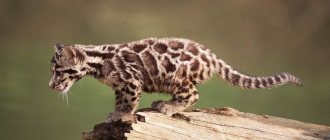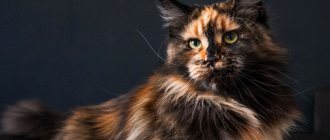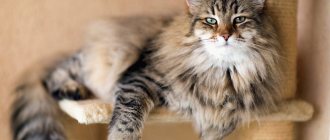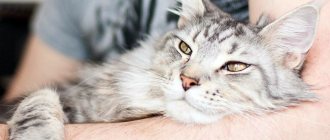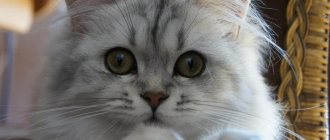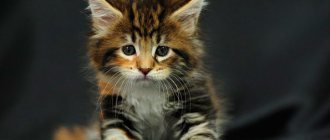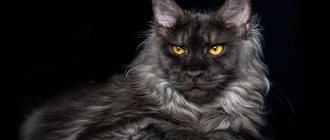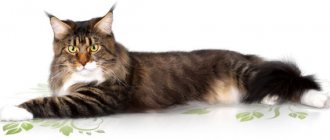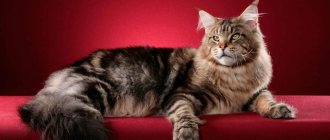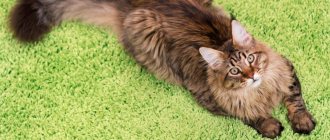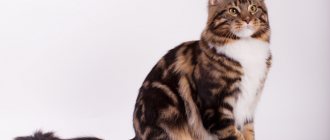One of the largest and most noble cats is the Maine Coon. This breed has a massive structure, so people often ask: what height and weight do these animals reach?
Folk tales say that this breed can reach a weight category of 25 kg. But these statements may concern some exceptions, because, as a rule, the weight of healthy Maine Coons without signs of obesity is a maximum of fifteen kilograms.
Average weights are seven kilograms for females and ten kilograms for cats. The length of these beauties from the withers to the tip of the tail often reaches 1-1.2 meters. In addition to such indicators as general size and body weight, the Maine Coon is characterized by other details, because they are all increased in size relative to other animals.
This is a long, wide tail, giant paws, and a massive muzzle. Having all these characteristics in combination, the Maine Coon looks like a huge representative of domestic cats, especially if there are ordinary cats in the house, which seem dwarfed against the background of the Coon.
Typical weight standards for cats and Maine Coon cats
All professional felinologists advise carefully monitoring how the kitten gains weight. And even after he reaches the age of one and a half years, one should not forget about periodic monitoring of the weight of an already adult cat. Since most often, even small deviations from the norm of a particular age of an animal can indicate an incipient disease. In this case, urgently taken measures are much more productive than treatment in the later stages of the disease.
So, speaking about weight standards, according to the age of the kitten, you need to remember the following figures:
- at neonatal age, which is no more than 4 days from the birth of a small Maine Coon, the normal weight gain during the day should be about 10 grams;
- if a newborn baby does not gain, but rather begins to lose weight, urgent measures must be taken;
- the suckling period of a kitten's life (the first 4 weeks) is characterized by a daily more or less stable increase in body weight by 20, or even 50 grams;
- As soon as the pet is 1 month old, its weight should be 620-750 grams. for males and 100 gr. less for women's;
- during the transition to the adult type of feeding (from 4 weeks of age to 7 weeks of age), weight gain slows down slightly, but at the end of this period it stabilizes again and the weight of the cat should reach 1.3-1.5 kg, and that of cats - up to 1.1- 1.3 kg.
Then the independent, “adult” life of the newly-minted household member begins. By the way, I would like to note that weight indicators may vary with small errors, which in no way indicate a possible illness in the cat. Rather, they will demonstrate factors related to the living conditions and lifestyle of the Maine Coon, as well as dependence on the breed variety.
Upon reaching the age of three months, the weight of a female individual can grow up to 2 kg, and a male one – even up to 2.7 kg. For comparison, I’ll take six-month-old Maine Coons. Males at this age gain twice as much weight (4-6 kg), as do females. They weigh about 3.5-4.5 kg. Peak weight gain is observed at one to one and a half years of age. The body weight of an adult, respectable cat during this period of time can reach up to 10 kg (lower threshold - 6 kg), and females - 6.5-7 kg (lower threshold - 4.5 kg).
Signs of exhaustion
When wondering why a cat is thin, and whether this is normal, factors such as normal and painful thinness are taken into account. In the first case, we are talking about the weight standard that an animal of a particular breed must meet at a certain age. The second is about exhaustion. A cat that is too thin is most likely sick and requires long-term rehabilitation therapy, which can only be prescribed by a specialist.
Appearance standards for British breeds
What can you do if your little Maine Coon is not gaining weight?
As I noted earlier, as soon as the first signs of weight loss in newborn kittens appear, it is necessary to urgently contact specialists. Sometimes this is a completely unworthy indicator. It’s just that a difficult birth of a mother cat could provoke a stressful state of the kitten and in a few days, as soon as the cat returns to normal, the baby’s health will also normalize. And he will slowly begin to make up for lost grams.
However, more often in such cases, doctors advise feeding the little patient a little and prescribing complex therapy:
- vitamins to maintain energy balance in the body;
- homeopathic remedies to relieve stress;
- auxiliary feeding to replenish the missing substances that for some reason do not enter or are not absorbed in the kitten’s body.
If the cat that gave birth to small Maine Coons is small in size, then the kittens can take much longer to gain height and weight. In this sense, it is much easier for large individuals. Kittens from such cats are initially born with good body weight, which allows them to quickly gain the necessary grams.
Causes of exhaustion
Exhaustion, or cachexia, develops under the influence of exogenous (external) and endogenous (internal) factors.
Exogenous
Exogenous external causes of exhaustion include:
- lack of food (emaciation is observed in feral cats and animals that receive food from time to time);
- impaired swallowing functions (the cat has something stuck in its throat, the nasopharynx is inflamed due to an insect bite, under the influence of allergens);
- problems with teeth (inflammation in the oral cavity, caries, tartar - all this prevents the animal from eating its usual food).
Natural Cause of Thinness
An adult cat should receive at least 70 g of dry food per day. If the cat is nursing offspring or is sick, the norm is doubled. At the same time, there should always be only fresh food in the bowl, as many food manufacturers warn about.
Endogenous
Endogenous (internal) factors that provoke cachexia include diseases of a non-infectious and infectious nature. Cats lose weight due to the development of:
- oncological diseases;
- cardiovascular pathologies;
- diabetes mellitus;
- chronic infections (infectious peritonitis, immunodeficiency, leukemia).
Cachexia is caused by hormonal disorders, problems with the pancreas, dysfunction of the kidneys, liver, and pituitary gland.
Sometimes weight loss occurs due to:
- the occurrence of a stressful situation (if the cat is given into the wrong hands, often transported);
- bearing offspring and feeding kittens (nursing cats often become excessively thin, so that a thin cat does not become completely exhausted and gets sick, kittens are weaned as soon as they begin to feed on their own);
- vitamin deficiency (feed must be balanced, it is useful to give the cat additional vitamins);
- formation of hairballs in the stomach (from time to time pets are given special tablets to cough it up);
- infection of the pet’s body with helminths (parasites release dangerous toxins, weaken the cat, their activity over time leads to physical pain, which causes apathy and loss of appetite).
An adult, non-castrated cat loses weight when the heat begins. In the spring, cats literally forget about everything in the world, including food, they move a lot and eat poorly, so they lose weight. Females also lose weight for this reason, but it is males who experience significant changes.
Important! Older cats move less, sleep a lot and, accordingly, eat less, which affects their body weight.
If a one-year-old or older Maine Coon suddenly begins to lose weight
For males and females of the Maine Coon breed, weight standards are no less important than for other representatives of the cat family. You can quickly find your way around them if you suddenly see signs of an obvious illness in your pet. And here it is important to get your bearings in time. Don't let the weight loss process take its course. The reasons for such a decrease in body weight in fully grown cats may be of the following nature:
- sudden change in diet or regimen;
- unbalanced diet;
- parasites and diseases caused by them;
- differences by gender (adult cats gain weight more slowly than males);
- genetic abnormalities;
- hormonal imbalance in the body;
- failure to comply with sanitary and hygienic standards for keeping furry pets;
- a sudden or constant external influence that causes the cat to experience severe stress or repeated stressful conditions.
As soon as you notice that your Maine Coon is not gaining weight, the first thing you should pay attention to is the diet, routine, nutritional balance and the presence of a stress factor. If there have been no sudden changes in diet recently, or stress, then you should immediately take your cat for examination. However, we should not forget that uncastrated and unsterilized male cats begin to eat poorly at certain times of the year and, as a result, lose weight. This factor should also be taken into account before engaging in self-hypnosis about a possible “terrible” illness in your cat.
Maine Coons are friendly, very beautiful domestic cats of American origin. This rather rare, but already popular breed surprises with its weight and size. Anyone who wants to become the owner of such a cat, encounters these animals at exhibitions or sees photos of a Maine Coon cat on Internet sites, is primarily interested in the question of what body weight this pet can achieve.
There are legends about giant cats whose weight exceeds 20 kg, but in reality there are no such representatives of this species. None of the exhibitions have ever registered a cat with such an indicator. The largest, most massive animals weigh up to 7 kg for cats and no more than 10 kg for cats.
Even neutered representatives of the breed who have excess fat deposits do not weigh more than 12 kg.
As a rule, cats are smaller than males, but some two-year-old females can be significantly larger than a one-year-old cat. Cats become larger after their first birth. And cats used for breeding can be very thin, since the mating process requires a lot of energy from the animal.
Neutered Maine Coons look the most standard for the breed, since their weight is not affected by hormonal fluctuations: they are always in an excellent mood and stand out with their magnificent coat. Castration also provides other benefits: it minimizes possible marks and unpleasant sprees. See also: when to castrate a Maine Coon.
The main condition for raising a castrate is strictly dosed feeding and physical activity to regulate the animal’s weight.
The apparent massiveness is achieved due to the fact that Maine Coons have a long, elongated body. The length of the cat’s body from the nose to the end of the heavily pubescent tail can be more than a meter: the current record is 1 m 23 cm.
In addition, they have very solid muscles, strong paws, a large head set on a massive neck, and a voluminous collar on the shoulders. Therefore, a cat weighing 9 kg sometimes gives the impression of a very large animal weighing 15 kg or more.
Normal thinness
A cat's weight has a lot to do with its age and breed:
- a domestic mongrel cat at the age of 1 year weighs from 2.5 to 4.5 kg (naturally, the figures may differ, but usually not significantly);
- a purebred cat at 1 year weighs from 3.5 to 5 kg;
- a cat of the British breed, reaching one year of age, weighs up to 4.5-4.6 kg;
- A British cat normally weighs from 4.5 to 7 kg, provided it receives the right amount of food.
Each of the existing cat breeds has its own weight table, which all animal owners must follow.
In a healthy cat:
- it is easy to feel the ribs and spine, but they are not visible from the side;
- there is a small amount of fat in the abdomen, back and chest;
- the waist line is clearly visible;
- the stomach does not sag, it is almost non-existent.
A cat can lose weight or gain weight while feeding or bearing kittens, and a cat during the mating period. This kind of thinness is considered normal. Sometimes an animal suddenly loses weight after experiencing stress (moving, a trip to the veterinarian). And that's okay too. If the kitten’s parents were not large or purebred, then you should not expect that after 1-2 years the pet will turn into a fat lazy cat, as in the picture in the advertisement.
Outbred cats are smaller and lighter than their purebred counterparts and even those animals that appeared as a result of crossing a purebred pet with a barn cat. The kittens will still be larger than those that an ordinary yard cat gives birth to, and accordingly, they will also weigh more.
Maine Coon kittens - development conditions
From the moment of birth, Maine Coons differ from other cat breeds in their larger dimensions. If, for example, Persian babies are born with a body weight of 80-120 g, then Maine Coons weigh from 120 to 170 g at birth (see the weight of Maine Coon kittens by month in the table).
According to average statistics, babies are born weighing 130 g. The body weight and development of the Maine Coon are determined by a number of conditions that depend not only on nature, but also on the person caring for the newborn.
The growth rate of a kitten is influenced by the genetic characteristics of the breed and other natural factors:
- volume of the litter : the weight of the kittens directly depends on the number of kittens born at the same time - if the litter consisted of five babies, then the average weight of the kittens will be in the range of 120-130 g, but if one kitten was born, then it will be quite large and weigh about 150-160 g ;
- condition of the animal at birth : weak kittens with intrauterine development disorders gain weight and develop more slowly than their brothers and sisters;
- Maine Coon breed : the greater the weight determined by the characteristics of the breed, the faster the kittens will grow;
- sex of the animal : as they grow, the discrepancy in body weight increases; by the 3rd - 4th month of life, male Maine Coons outweigh their litter sisters (see Maine Coon weight at 4 months);
- weight of the parent : the larger and more powerful the cat, the better its health, the faster the offspring grows;
- hormonal drugs : their use for medicinal purposes leads to disruption of the animal’s endocrine system, which negatively affects the development of young animals;
- combination of genotypes : the genes of both parents create a unique organism, which is manifested in the formation of the skeleton, muscular system and, accordingly, in the speed of development of the offspring.
Some external circumstances also have a significant impact on the development of the Maine Coon:
- sanitary and hygienic conditions of the place where young Maine Coons grow and develop;
- stressful situations, such as loud noise, temperature changes, the presence of other animals and other unfavorable circumstances that negatively affect the state of the endocrine system of kittens and their growth;
- A complete diet for a pregnant and then lactating cat is a mandatory requirement for excellent growth of the young and their viability.
The average weight gain for a newborn Maine Coon should be at least 10 g daily.
A slight loss in mass is allowed only at the first stage of development. If body weight does not increase within two days, serious measures must be taken.
The kitten's diet includes supplementary food with vitamins and homeopathic medicines. It is quite possible that a kitten will only need a couple or three days of taking artificial food to regain strength and gain the missing weight. Then it can be gradually transferred to a regular diet.
Young Maine Coons double their body weight by 10 days of age, quadruple by the first month of life, and eightfold by two months. The peak point of litter growth occurs in the fifth month, when daily weight is close to maximum. At this stage, kittens have significant energy demands.
When is it time to sound the alarm?
Cats begin to worry about being thin if:
- the cat eats a lot and often, but does not gain weight, it is too light and small for its breed (thin cats do not gain weight);
- the spine can be traced visually (the ridge literally protrudes outward);
- the pelvic bones and ribs protrude, their movement is clearly noticeable when the cat moves;
- the cat’s breath smells unpleasant (obviously, the gastrointestinal tract is disrupted, the kidneys and liver are not functioning properly, plaque or caries may have formed on the teeth);
- there is no fat layer on the chest and back area, only bone;
- the cat does not show usual attention to toys, sleeps constantly;
- the animal has loose stools (if mucus, blood, or undigested parts of food are found in the stool, consult a doctor);
- yellowness or excessive pallor of the mucous membranes is observed, they become gray in color (most likely, weight loss is due to problems with the liver and kidneys);
- more fluid is released from the eyes, nose and mouth than usual, especially when an unpleasant odor appears, a change in the color of the animal’s tears and saliva;
- the temperature rises (hot nose, the cat is lethargic, to check the temperature it is enough to use a regular thermometer);
- the stomach is sunken, hard, tense.
The silhouette of an emaciated cat resembles an hourglass.
When the described signs appear, the animal is weighed (to do this, just place it in a bag and use a steelyard or in a cardboard box, cover the top with something and put it on a regular floor scale).
If the cat always eats well, but is very thin, weighs 1 kg or more less than it should, contact a veterinarian. It is first necessary to take weight measurements for several weeks in a row to make sure that there really is a reason for concern (cats are thin and do not gain weight for various reasons, but most often due to illness).
Body weight at different stages of development
From the moment of birth to the peak stage of growth, the development of the Maine Coon is divided into four main stages:
- Stage one: neonatal. It lasts for the first four days. Average daily weight gain is directly related to the condition of the baby after birth.
- Stage two: sucking. The stage continues for the next 4 weeks. Body weight increases steadily and evenly: the average increase is from 20 to 50 g. By the end of the first month of life, kittens of the same litter level out, and prenatally underdeveloped babies are restored to a normal state. The weight of a one-month-old kitten should be from 0.5 to 0.8 kg, and that of a two-month-old kitten should be from 0.9 to 1.5 kg.
- Stage three: transitional. The stage continues until seven weeks of age. It is characterized by a change in the type of feeding. In the fifth week, due to the transition to solid food, a slowdown in weight gain is acceptable. But by the seventh week this transition ends and body weight should rise again. Kittens begin to gain weight, as the new diet includes almost all the required vitamins and nutrients.
- Stage four: post-suction stage. The period lasts from the eighth week until the animal completes its growth. These are the kitten’s first steps towards an existence independent from its parent. Growth stops by the age of three, and the final formation of the body ends at 4–5 years of life.
Why doesn't a castrated cat get fat?
There is an opinion among owners of cats that have not yet been neutered that as soon as castration occurs, absolutely everything in the character, lifestyle and behavior of the animal will change. Cats become calm and even lazy, stop marking, and begin to quickly gain weight. In relation to probably 70-80% of castrated animals, this opinion is justified, since it is based on the knowledge that after the procedure the hormonal levels change, the cat’s metabolic processes slow down, which means it becomes less energetic. But this doesn't always happen.
Note! If the animal was neutered late, at 1.5-2 years, then there is a high probability that there will be no sudden changes, so the sight of a skinny cat should not be alarming.
